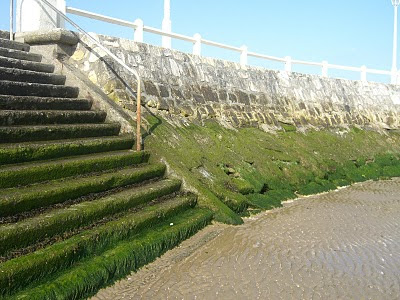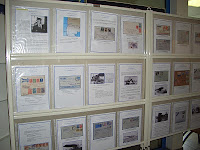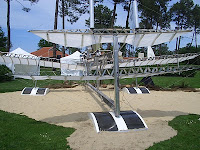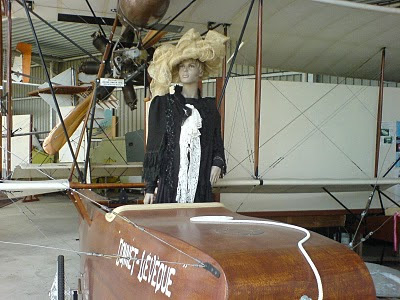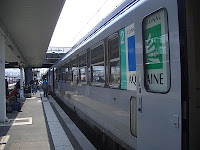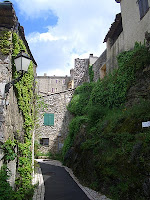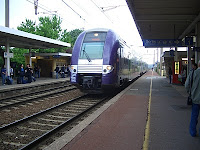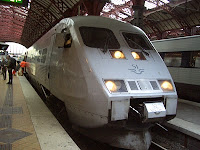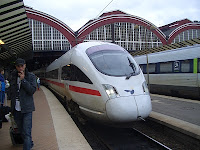We have several morning hours before we have to leave, so we walk down to the beach. It is hors saison so we have it to ourselves.
We walk in the sand just by the water. The sand is unpredictable, sometimes it holds, sometimes our feet sink deep. Shells have accumulated right by the edge of the wet sand. The only others on the beach are a woman and her daughter, the latter perhaps eightish is digging a sand castle when we pass. She is so like the Only-Begotten Daughter at that age. Suddenly a thought strikes her and she rushes off to the wet sand. She stops, jumps ahead on one foot and then carefully treading creates a design in the sand—a heart. A new jump inside the heart, making letters, adjusts them balancing on one foot. Finally it is ready and she runs, runs to fetch her mother. Je t’aime, Maman ! She gets a kiss on the cheek and maman photographs the heart.
Further along the beach a sand artist has created a menagerie.
We walk by the sea in the not yet quite warm breeze. Finally we have to return to the hotel via the local E Leclerc where we buy food for the day. It is another of the French stores that no longer sell single-use plastic bags, we get a sturdy bag to haul our stuff in. On the way to the railway station we stop in a chocolate store and buy presents for deserving friends at home.
 At the railway station I notice in passing that the arrivals/departures displays have been covered up and the timetables instead written on big sheets of paper, but our train seems to run on time anyway, so I think no further of it. The train to Bordeaux is clean, modern and very high, as if originally intending to be a double-decker but preferring a high ceiling instead. We leave on time at 11:25 and arrive in Bordeaux 50 minutes later.
At the railway station I notice in passing that the arrivals/departures displays have been covered up and the timetables instead written on big sheets of paper, but our train seems to run on time anyway, so I think no further of it. The train to Bordeaux is clean, modern and very high, as if originally intending to be a double-decker but preferring a high ceiling instead. We leave on time at 11:25 and arrive in Bordeaux 50 minutes later.According to the original itinerary laid out by the DB planner, we should now proceed by a series of local trains via Coutras, Angoulême, and Poitiers to Paris, but I had found out that there was actually a direct TGV from Bordeaux to Paris with which we could leave a lot later and thus have time for a look at Bordeaux, so we just need to rebook our tickets. We deposit our bags in the luggage deposit (Yay, there is one!)—the bags get x-rayed and we are told that laptops are not allowed to be stored, strictly forbidden, so I have to take it out and carry it around in Honeybuns’s handbag, but at least the rest of the bags get in a locker.
There is quite a bit of people in queue at the ticket desks. I glance at the departure table and note that our original departure isn’t shown, but local trains may of course be displayed somewhere else. We finally arrive at the desk and I present my case, we want to take the direct train from here to Paris, arriving no later than 20:30, and no, we don’t want to leave immediately, but with a later train. The ticketeer starts working on her terminal, looking very concerned. Things don’t come out the way she wants. She fetches assistance, this person just glances at the screen and gives up, she fetches another person who also leaves her to it with no further concern. She is much distressed. She explains that it will be quite expensive to rebook. Oh, well, hm, it will be much more convenient, so let’s go for it. She works away at the terminal with the look of a marathoner with too much distance left to the finish. Eventually she succeeds with whatever she’s been doing and explains that she can’t refund us for the unused ticket, we have to do that at the site of purchase, but she has new reservations for us at 3 EUR each. Excellent! I thank her profusely and we walk away. I then have a look at the tickets. Oh no! They are for a train that will arrive 21:30, much too late for our connection! I rush back and wait while she finishes the next client, then break in and explain that we have to arrive 20:30. She gives me a look of unbearable suffering, but starts working on her machine again, cancelling the just-issued tickets and then printing out new ones (and receipts and whatever, a lot more comes out of the printer than I get in my hand). This time I check the times of the tickets before leaving the desk; they are now OK. But, they require us to first take a bus to Libourne. By now I have added up all the little signs and signals that have been shouting at me for the last few hours and realise that SNCF are taking the opportunity to perform some much needed maintenance during the long weekend and there are in fact severe traffic disruptions over the entire region. Specifically they are today replacing the bridge over the Garonne just outside the railway station, so all traffic northwards has to go by bus at the moment. Presumably the ticket lady assumed I was well aware of this and that that was why I wanted to change our tickets. Oh well, at least we got the right ones, even if by accident.
Now, out to have a look at Bordeaux. We pick the first little restaurant across from the station for lunch. The waiter automatically addresses us in quite passable English, the first time this has happened during this trip. The food is quite passable as well.
 Now what? I’ve spied a biggish church some distance away, there’s bound to be something to look at there, so we walk towards it on rue Fieffé, a little back street that stretches out like a yawning cat in the sunshine. Everybody must be doing lunch right now, the only other person we see is a sushi deliverer. We reflect on the incongruity of this: the houses along the street do not seem particularly posh and are sometimes downright shabby, but the parked cars look expensive. This has also been a pattern in the other places we’ve been, that the houses often seem pretty neglected. One could imagine that this is because the climate allows this, but even in Provence winters get quite cold and surely even more so here by the Atlantic coast. Perhaps it has something to do with arcane French legislation making it complicated to renovate houses, or maybe it simply is more important to have a well-polished car.
Now what? I’ve spied a biggish church some distance away, there’s bound to be something to look at there, so we walk towards it on rue Fieffé, a little back street that stretches out like a yawning cat in the sunshine. Everybody must be doing lunch right now, the only other person we see is a sushi deliverer. We reflect on the incongruity of this: the houses along the street do not seem particularly posh and are sometimes downright shabby, but the parked cars look expensive. This has also been a pattern in the other places we’ve been, that the houses often seem pretty neglected. One could imagine that this is because the climate allows this, but even in Provence winters get quite cold and surely even more so here by the Atlantic coast. Perhaps it has something to do with arcane French legislation making it complicated to renovate houses, or maybe it simply is more important to have a well-polished car.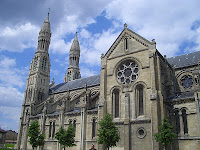 We find the silent and empty Sacré Cœur and have a look-see inside it. Another couple also come in, they disappear with determined steps through a passage behind the chancel. Still, we are not exactly in the bustling cite centre, so we return to the station along a parallel street and then decide to see what we can find in the other direction. This seems to be more towards the centre, we arrive at the Garonne with a park along the riverside as far as we can see. We walk through it until it’s time to return to the station. We note that Bordeaux is built of the same drably pale grey stone as is Paris, a letdown from the brighter-coloured buildings in the south.
We find the silent and empty Sacré Cœur and have a look-see inside it. Another couple also come in, they disappear with determined steps through a passage behind the chancel. Still, we are not exactly in the bustling cite centre, so we return to the station along a parallel street and then decide to see what we can find in the other direction. This seems to be more towards the centre, we arrive at the Garonne with a park along the riverside as far as we can see. We walk through it until it’s time to return to the station. We note that Bordeaux is built of the same drably pale grey stone as is Paris, a letdown from the brighter-coloured buildings in the south. We retrieve our bags and then locate the bus station when shuttle busses to Libourne leave. The trip is not all that long (but I get very excited when I notice an Airbus 380 fuselage transport barge in the river, on its way to Toulouse) and Libourne seems a nice enough little town with the usual mediæval accoutrements. However, its railway station has probably never before seen this many passengers at one time, the little waiting hall is full of people milling around and the coffee shop and newspaper hawker are making brisk business. Still, there is no particular chaos, there have been scores of people in SNCF jackets guiding people and the trains are basically running on (the rearranged) schedule.
We retrieve our bags and then locate the bus station when shuttle busses to Libourne leave. The trip is not all that long (but I get very excited when I notice an Airbus 380 fuselage transport barge in the river, on its way to Toulouse) and Libourne seems a nice enough little town with the usual mediæval accoutrements. However, its railway station has probably never before seen this many passengers at one time, the little waiting hall is full of people milling around and the coffee shop and newspaper hawker are making brisk business. Still, there is no particular chaos, there have been scores of people in SNCF jackets guiding people and the trains are basically running on (the rearranged) schedule.So, the 17:41 non-stop TGV service leaves on the dot and we travel north through a flattening landscape. We again reflect over the many seemingly abandoned buildings and ruins along the way. Parallel with the railway is a canal system we curiously study. At 20:30 we arrive at Gare de Montparnasse, a brutalist concrete maze. We quickly disappear down into the Métro, from which there is a straight connection to Gare de l’Est.
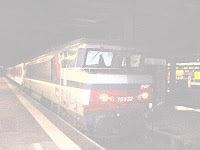 From Gare de l’Est we just retrace our tracks. Non-stop TGV at 21:39 to Metz at 23:02 where we catch up with the City Night Line that had left Gare de l’Est several hours before we arrived there. We continue to Hannover Hbf, 23:53–07:02. ICE from Hannover Hbf to Hamburg Hbf, 07:36–08:53. ICE from Hamburg Hbf to København H, 09:28–14:11, with ferry. X2000 from København H to Stockholm C, 16:19–21:39.
From Gare de l’Est we just retrace our tracks. Non-stop TGV at 21:39 to Metz at 23:02 where we catch up with the City Night Line that had left Gare de l’Est several hours before we arrived there. We continue to Hannover Hbf, 23:53–07:02. ICE from Hannover Hbf to Hamburg Hbf, 07:36–08:53. ICE from Hamburg Hbf to København H, 09:28–14:11, with ferry. X2000 from København H to Stockholm C, 16:19–21:39.Then we just have to get to the cat minder, retrieve angry cat from under the sofa, stuff both cats into travel basket, clean up all traces after them and cart them home where we finally drop in bed late, late at night. I never bother reclaiming the 6 EUR for the unused tickets.
